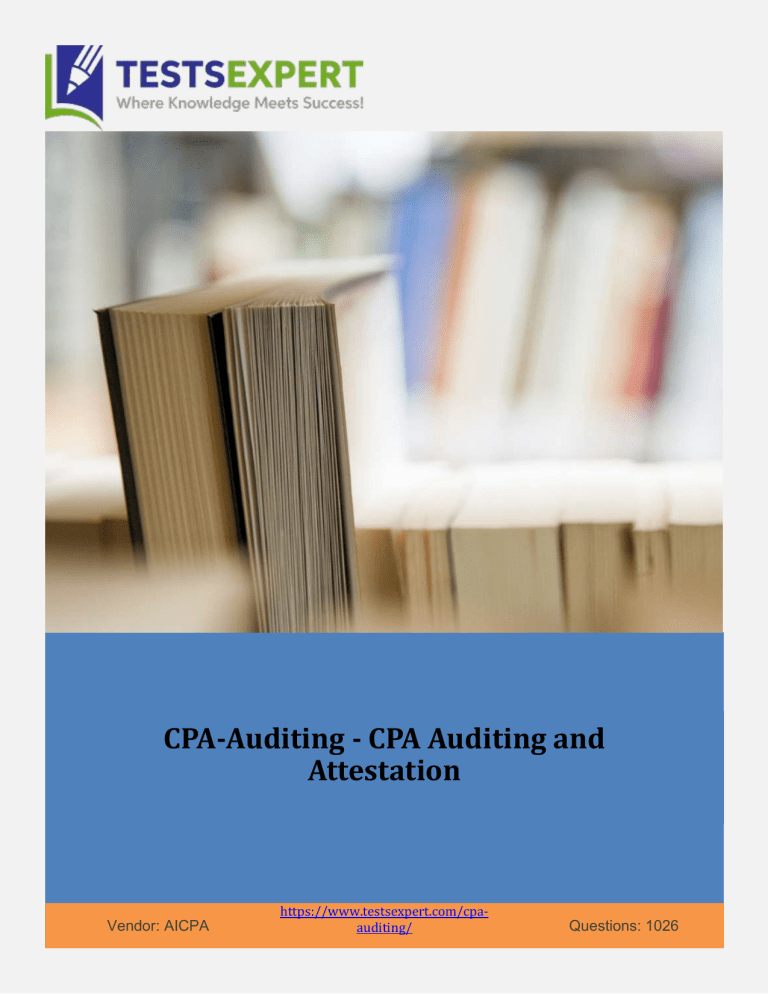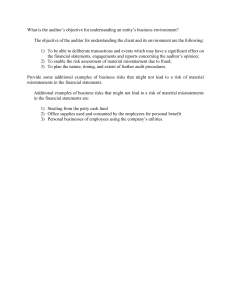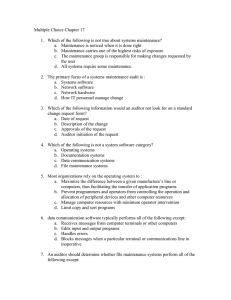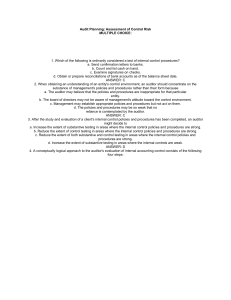Updated CPA-Auditing Exam Certification Test Preparation Questions Answers PDF
advertisement

CPA-Auditing - CPA Auditing and Attestation Vendor: AICPA https://www.testsexpert.com/cpaauditing/ Questions: 1026 Question: 1 Several sources of GAAP consulted by an auditor are in conflict as to the application of an accounting principle. Which of the following should the auditor consider the most authoritative? A. FASB Technical Bulletins. B. AICPA Accounting Interpretations. C. FASB Statements of Financial Accounting Concepts. D. AICPA Technical Practice Aids. Answer: A Explanation: Choice "a" is correct. In accordance with the GAAP hierarchy, FASB Technical Bulletins are considered the most authoritative of the sources listed in the question. Choice "b" is incorrect. Of the sources listed, AICPA Accounting Interpretations would be considered the second most authoritative. Choice "c" is incorrect. FASB Statements of Financial Accounting Concepts are among the least authoritative sources of GAAP available to auditors. Choice "d" is incorrect. AICPA Technical Practice Aids are among the least authoritative sources of GAAP available to auditors. Question: 2 For an entity's financial statements to be presented fairly in conformity with generally accepted accounting principles, the principles selected should: A. Be applied on a basis consistent with those followed in the prior year. B. Be approved by the Auditing Standards Board or the appropriate industry subcommittee. C. Reflect transactions in a manner that presents the financial statements within a range of acceptable limits. D. Match the principles used by most other entities within the entity's particular industry. A Strategic Guide to Excel in the CPA-Auditing Exam The Certified Public Accountant (CPA) journey is a hallmark step towards a distinguished career in auditing, and success in the CPAAuditing exam is the gateway to professional excellence. This article unveils a strategic guide, seamlessly integrating valuable insights to empower aspiring CPAs in their preparation for this critical certification. A Strategic Guide to Excel in the CPA-Auditing Exam On the Certified Public Accountant (CPA) journey is a hallmark step towards a distinguished career in auditing, and success in the CPAAuditing exam is the gateway to professional excellence. This article unveils a strategic guide, seamlessly integrating valuable insights to empower aspiring CPAs in their preparation for this critical certification. 1. Mastering the Exam Blueprint: The Foundation for Success Understanding the exam blueprint is Answer: C Explanation: Choice "c" is correct. Financial statements are presented fairly in conformity with GAAP when there are no material misstatements included therein. The fact that there may occasionally be immaterial misstatements means that the financial statements are correct "within a range of acceptable limits." Choice "a" is incorrect. Accounting principles may change from year to year. As long as such changes are properly accounted for, the financial statements are still in conformity with GAAP. Choice "b" is incorrect. The AICPA and the FASB determine GAAP, not the Auditing Standards Board. Choice "d" is incorrect. There is no requirement that an entity's financial statements be prepared in accordance with prevalent industry practices in order to be in conformity with GAAP. Question: 3 Which of the following statements is correct concerning an auditor's responsibilities regarding financial statements? A. An auditor may not draft an entity's financial statements based on information from management's accounting system. B. The adoption of sound accounting policies is an implicit part of an auditor's responsibilities. C. An auditor's responsibilities for audited financial statements are confined to the expression of the auditor's opinion. D. Making suggestions that are adopted about an entity's internal control environment impairs an auditor's independence. Answer: C Explanation: Choice "c" is correct. An auditor's responsibility is to express an opinion on financial statements based on an audit. Choice "a" is incorrect. An auditor may draft an entity's financial statements based on information from management's financial system. This would be referred to as a compilation engagement. Choice "b" is incorrect. The adoption of sound accounting policies is an implicit part of management's responsibilities, not the auditor's responsibilities. Choice "d" is incorrect. An auditor often makes suggestions that are adopted about an entity's internal control environment. Professional Standards Question: 4 Which of the following provides the most authoritative guidance for an auditor? A. An AICPA audit and accounting guide that provides specific guidance with respect to the accounting practices in the client's industry. B. A Journal of Accountancy article discussing implementation of a new standard. C. General guidance provided by a Statement on Auditing Standards. D. Specific guidance provided by an interpretation of a Statement on Auditing Standards. Answer: C Explanation: Choice "c" is correct. General guidance provided by a Statement on Auditing Standards is the most authoritative of level of auditing guidance. Auditors are required to comply with SASs, and should be prepared to justify any departures therefrom. Choices "a" and "d" are incorrect. AICPA audit and accounting guides and SAS interpretations are interpretive publications that provide guidance regarding how SASs should be applied in specific situations. They are not as authoritative as SASs. Choice "b" is incorrect. Journal of Accountancy articles have no authoritative status but may be helpful to the auditor. Question: 5 Which of the following accurately depicts the auditor's responsibility with respect to Statements on Auditing Standards? A. The auditor is required to follow the guidance provided by the Standards, without exception. B. The auditor is generally required to follow the guidance provided by Standards with which he or she is familiar, but will not be held responsible for departing from provisions of which he or she was unaware. C. The auditor is generally required to follow the guidance provided by the Standards, unless following such guidance would result in an audit that is not cost-effective. D. The auditor is generally required to follow the guidance provided by the Standards, and should be able to justify any departures. Answer: D Explanation: Choice "d" is correct. The auditor is generally required to follow the guidance provided by the Standards, and should be able to justify any departures. Choice "a" is incorrect. On rare occasions, the auditor may depart from the guidance provided by the SASs, but he or she must justify such departures. Choice "b" is incorrect. Lack of familiarity with a SAS is not a valid reason for departing from its guidance. The auditor is expected to have sufficient knowledge of the SASs to identify those that are applicable to a given audit engagement. Choice "c" is incorrect. The cost associated with following the guidance provided by a SAS is not an acceptable reason for departing from its guidance. Question: 6 In the first audit of a new client, an auditor was able to extend auditing procedures to gather sufficient evidence about consistency. Under these circumstances, the auditor should: A. Not report on the client's income statement. B. Not refer to consistency in the auditor's report. C. State that the consistency standard does not apply. D. State that the accounting principles have been applied consistently. Answer: B Explanation: Choice "b" is correct. The auditor's standard report implies that the auditor is satisfied that the comparability of financial statements between periods has not been materially affected by changes in accounting principles and that such principles have been consistently applied between or among periods. Since the auditor has gathered sufficient evidence about consistency, no reference need be made in the report. Choice "a" is incorrect. If the auditor is able to obtain sufficient evidence about consistency, the auditor may report on the entity's financial statements. Choice "c" is incorrect. The consistency standard is one of the ten GAAS, and it does apply to this audit. Choice "d" is incorrect. If the auditor is able to obtain sufficient evidence about consistency, no mention of consistency need be made. Consistency is implied in the standard report. The CPA-Auditing exam is not merely a test of knowledge but a journey toward professional eminence. Seamlessly integrate these strategic elements into your study plan to enhance your chances of success. As you navigate the complexities of auditing principles, remember that each milestone brings you closer to becoming a Certified Public Accountant, equipped to make a lasting impact in the dynamic world of auditing and assurance. Embrace the challenge, stay focused, and excel in the CPA-Auditing exam—your key to a prosperous career in accounting and auditing. Visit a webpage: https://www.testsexpert.com/cpa-auditing/


